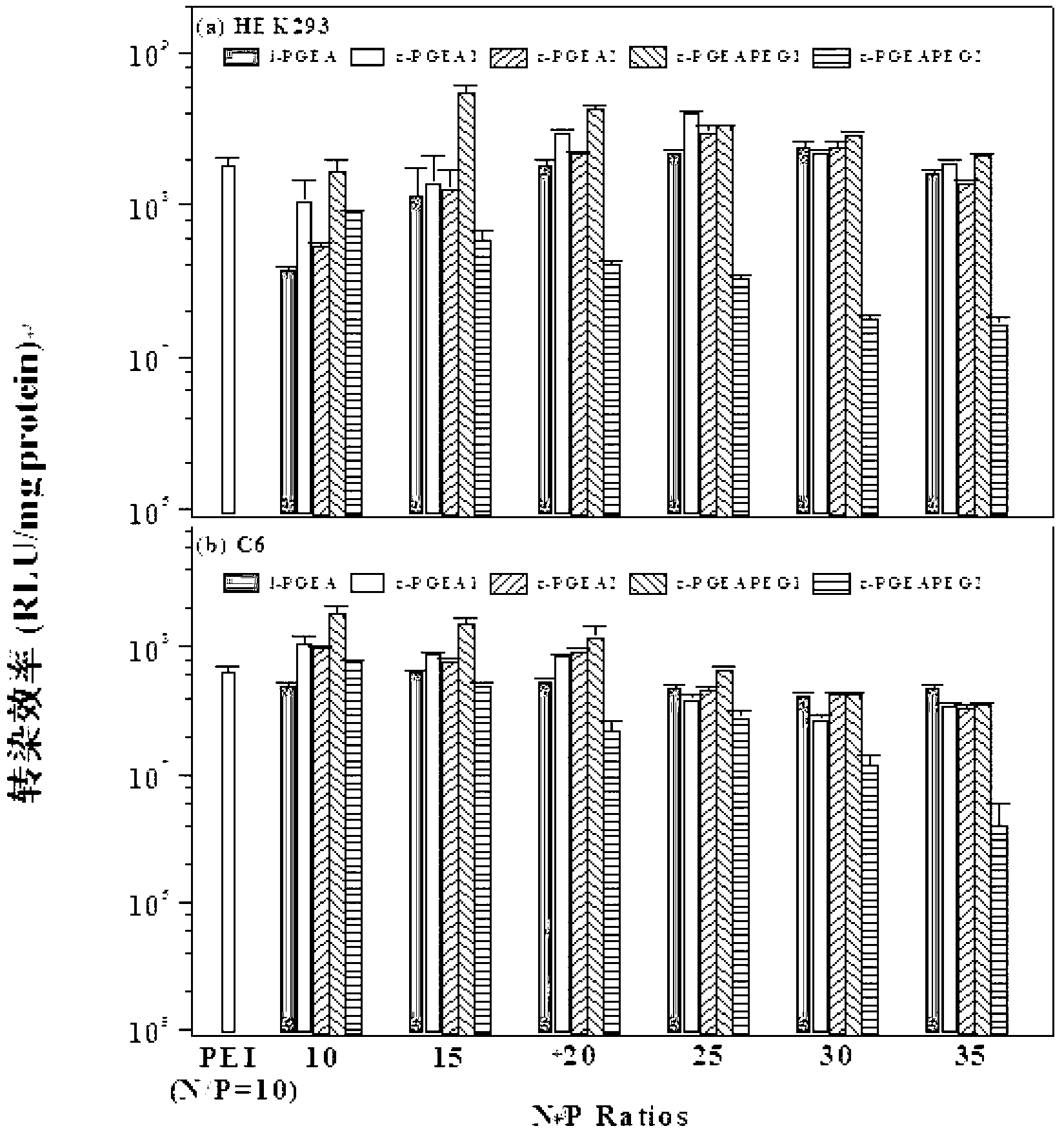ATRP method for constructing cationic gene vector with PGMA as skeleton
A gene carrier and cationic technology, applied in the field of cationic gene carriers, can solve the problems of different vector transfection efficiency and protonation ability, and achieve the effect of simple use, easy regulation and good storage stability
- Summary
- Abstract
- Description
- Claims
- Application Information
AI Technical Summary
Problems solved by technology
Method used
Image
Examples
Embodiment 1
[0035] 1) Continuous reaction under nitrogen protection conditions at 50°C, add 12g of GMA (glycidyl methacrylate) into a small flask, then add 10g of THF (tetrahydrofuran), 120mg of pentamethyldiethylenetriamine, 213.6mg of PMDETA, and finally Add 86.4mg of CuBr to initiate active controllable free radical polymerization; after 3h, open the bottle stopper to accelerate stirring for 10min, fully contact with air to stop the reaction, and the polymerization product is repeatedly precipitated with methanol until the shape becomes solid, then put it in a vacuum drying oven to remove methanol , that is, linear PGMA is obtained, the number average molecular weight (Mn) of the polymer is 580000g / mol, and the PDI (Mw / Mn) is 1.23.
[0036] 2) Continuous reaction under nitrogen protection at 50°C, add 0.3g of linear PGMA obtained in step 1) to 5.6g of THF to dissolve, then add 3g of ethanolamine (or use 2-amino-1-propanol, 3-amino-1- Propanol, N-N-dimethylethylenediamine, or 0.15g etha...
Embodiment 2
[0038] 1) Continuous reaction under nitrogen protection at 37°C, take 1.5 g of the linear PGMA obtained in step 1) of Example 1 in a flask and dissolve it in 10 g of THF, add 0.36 g of BIBA (2-Bromoisobutyric acid), and react for 24 hours , ether precipitation, and vacuum drying to obtain PGMA-Br (PGMA / BIBA is 5:1, and one of every six GMA segments on the molecular chain is connected to Br).
[0039] 2) Continuous reaction under nitrogen protection at 50°C, add 0.3g of PGMA-Br obtained in the above step 1) into 5g of THF to dissolve, then add 4gGMA, 82mg of HMTETA in sequence, and finally add 33.5mg of CuBr to trigger active controllable free radicals Polymerization, after 4 hours of reaction, open the bottle stopper to accelerate stirring for 10 minutes, and fully contact with air to stop the reaction; the polymerization product is repeatedly precipitated with methanol until the product becomes solid, and then placed in a vacuum drying oven to remove methanol to obtain comb-sh...
Embodiment 3
[0042] 1) Continuous reaction under nitrogen protection at 37°C. Take 2.5 g of the linear PGMA obtained in step 1) of Example 1 in a flask and dissolve it in 10 g of THF. Add 0.37 g of BIBA (2-Bromoisobutyric acid) to react for 24 hours. Precipitate with ether and dry in vacuum to get PGMA-Br (PGMA / BIBA ratio is 8:1, one of every 8 GMA segments on the molecular chain is connected with Br).
[0043] 2) Continuous reaction under nitrogen protection at 50°C, add 0.3g of PGMA-Br obtained in the above step 1) into 5g of THF to dissolve, then add 4gGMA, 82mg of HMTETA in sequence, and finally add 33.5mg of CuBr to trigger active controllable free radicals Polymerization, after 4 hours of reaction, open the bottle stopper to accelerate stirring for 10 minutes, and fully contact with air to stop the reaction; the polymerization product is repeatedly precipitated with methanol until the product becomes solid, and then placed in a vacuum drying oven to remove methanol to obtain comb-shap...
PUM
| Property | Measurement | Unit |
|---|---|---|
| molecular weight distribution | aaaaa | aaaaa |
Abstract
Description
Claims
Application Information
 Login to View More
Login to View More - R&D
- Intellectual Property
- Life Sciences
- Materials
- Tech Scout
- Unparalleled Data Quality
- Higher Quality Content
- 60% Fewer Hallucinations
Browse by: Latest US Patents, China's latest patents, Technical Efficacy Thesaurus, Application Domain, Technology Topic, Popular Technical Reports.
© 2025 PatSnap. All rights reserved.Legal|Privacy policy|Modern Slavery Act Transparency Statement|Sitemap|About US| Contact US: help@patsnap.com



